New biodiversity impact assessment guidelines introduced as part of EIA review
Sign up now: Get ST's newsletters delivered to your inbox

The new biodiversity impact assessment guidelines will set out the methodologies that can be used in conducting wildlife surveys in an area marked for development.
ST PHOTO: LIM YAOHUI
Follow topic:
SINGAPORE - New guidelines for assessing the impact of development works on local flora and fauna have been introduced, under changes to the environmental impact assessment (EIA) framework.
This will render such impact assessments - which previously differed between consultants - less subjective.
The new biodiversity impact assessment guidelines will also set out the methodologies that can be used in conducting wildlife surveys in an area marked for development.
The guidelines are similar to those already in place for noise or pollution control at worksites, and will ensure that consultants assessing sites marked for development have a set of standards to follow during an EIA.
Previously, there was no locally standardised methodology in the EIA process for how such surveys should be conducted.
Quantifying the impact of development works on wildlife was also less transparent.
For example, when the Land Transport Authority revealed the results of the first phase of the EIA for the Cross Island MRT Line, which had looked at the impact of tests to determine the soil and rock profile under the nature reserve, the EIA had considered the impact of soil works as being "moderate", if mitigating measures were strictly enforced.
But it was not clear then what "moderate" meant.
The new guidelines, developed by the National Parks Board (NParks) in consultation with experts, will provide greater clarity when it comes to using such terms.
For instance, they set out three different impact assessment methodologies and recommendations for when they should be used.
One method is considered more comprehensive and recommended for EIAs, while the other two are recommended for preliminary studies.
The method NParks recommends for EIAs involves the assignment of an "environmental score" that takes into consideration factors such as the permanence of the change and the importance of the species, meaning whether it is locally or globally endangered.
These scores are then pegged to a band and labelled using such terms as "moderate negative change" or "major positive change".
A spokesman for consultancy Camphora explained that every EIA has three components.
They include the establishment of a baseline, which means detailing the plants and animals in an area, for instance through surveys; an assessment of how the works could impact the wildlife; and provide recommendations for environmental management and monitoring plans.
While the methodologies set out in the new guidelines could still be subjective, the spokesman said NParks had addressed this by spelling out minimum baseline efforts for EIAs.
They include detailing of the animal groups to be included in baseline surveys and the type of equipment that should be used , such as camera traps.
"Hydrology, a key compliment to biodiversity assessments especially in areas where there are water bodies, has also been included when before it was optional," he told The Straits Times.
"With a more reflective baseline, the margin of subjective assessments bias towards development can be reduced," he said.
Local context
EIAs are done before a new development is built.
They are a tool used around the world to inform decisions on how to modify development activity to reduce environmental impact.
But context is important.
The new biodiversity impact guidelines will ensure that Singapore's unique circumstances are taken into account when consultants assess the conservation value of a site.
For example, the 89-page document seen by The Straits Times sets out descriptors for main habitat types in Singapore, from primary forest to abandoned kampungs (villages) and plantations.
Explaining the rationale for this, NParks said much of Singapore's original forest was cleared during the colonial period for various land uses including plantations and settlements. These lands may have regenerated as secondary forests dominated by native or exotic plant species.
"Despite these being relatively recent regrown forest patches, they can harbour some native biodiversity," said NParks.
The guidelines also set out the criteria that consultants can use to identify sites of high conservation priority.
They include considerations of whether the area is home to locally and globally endangered species and whether it supports globally significant concentrations of migratory species.
Some examples of species that are globally common but endangered locally include the leopard cat, the Malayan porcupine and the Malayan horned frog.
These concerns follow previous environmental studies whose findings were disputed.
For example, the Nature Society (Singapore) had disputed the findings on the Mandai project and called the conclusion of the EIA commissioned by Mandai Park Holdings "highly questionable".
Another environmental study commissioned by the Housing Board, which had concluded that the secondary forests on which the new Tengah town will be built are of "low conservation significance" and relatively young, also came under fire from the community.
Mr Matthew Jury, director of projects at consultancy DHI Water and Environment, said the guidelines were a "great step" towards ensuring a more consistent and transparent assessment of biodiversity impacts in Singapore.
"Unfortunately there is a wide range of current practices, and not all of them meet the minimum standards expected by the authorities or the public," he said.
The guidelines capture current best practices, he said, citing the use of quantitative methods to more accurately predict potential impacts.
"Applying a simple and transparent impact assessment tool... is also an excellent way to provide an overview of the range of potential impacts from a development, identify the key concerns and focus the mitigation efforts on avoiding or minimising those," he said.

